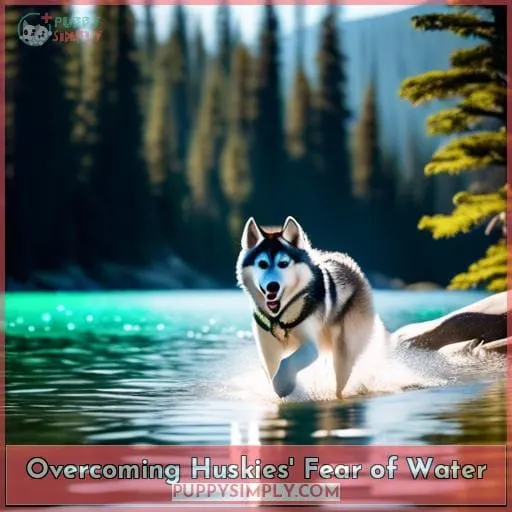This site is supported by our readers. We may earn a commission, at no cost to you, if you purchase through links.
 Imagine yourself as a husky, a creature of the snowy wilderness, your thick fur a shield against the biting cold.
Imagine yourself as a husky, a creature of the snowy wilderness, your thick fur a shield against the biting cold.
Water, to you, is an alien element, something to be avoided, a barrier to your freedom.
But what if you discovered a hidden affinity for the water, a joy in swimming that you never knew existed?
This article will embark on a journey to unveil the swimming habits and tips for huskies, revealing the potential for a harmonious relationship between these majestic canines and the allure of water.
Table Of Contents
- Key Takeaways
- Huskies’ Origins and Heritage
- Instinctual Behaviors of Huskies
- Factors Influencing Huskies’ Attitude Towards Water
- Understanding Huskies’ Relationship With Water
- Tips for Introducing Huskies to Water
- Huskies’ Affinity for Water
- Reasons for Huskies’ Hesitation to Swim
- Overcoming Huskies’ Fear of Water
- Frequently Asked Questions (FAQs)
- How does a husky’s double coat affect its ability to swim?
- Can huskies swim in warm water as well as they can in cold water?
- Are there any specific health considerations to keep in mind when taking a husky swimming?
- What are some common mistakes to avoid when introducing a husky to water for the first time?
- How can I tell if my husky is enjoying swimming or if it is just tolerating it?
- Conclusion
Key Takeaways
- Huskies’ ancestry and heritage contribute to their love for snowy landscapes and cold temperatures, but their attitude toward water can vary.
- Huskies’ instinctual behaviors, such as hunting and exploring, may translate to enjoying water activities, but pack mentality and territorial instincts can influence their comfort level in water.
- Factors influencing Huskies’ attitude toward water include personality, early experiences, and approach to introducing them to water, with positive experiences fostering love for swimming and negative experiences creating fear or aversion.
- Huskies’ relationship with water can vary based on character and experiences, with some enjoying cold environments and finding swimming refreshing while others prefer wading and playing in shallow water.
Huskies’ Origins and Heritage
Your husky’s ancestry grants them a unique heritage, shaping their relationship with water.
Bred by the Chukchi people, these Siberian canines possess a double coat that insulates them against frigid temperatures and icy waters.
Their thick fur, acting as a natural wetsuit, allows them to thrive in environments where other breeds might struggle.
This adaptation to the cold has led to huskies becoming renowned for their ability to withstand harsh conditions, making them exceptional companions for those seeking adventure in snowy landscapes.
Instinctual Behaviors of Huskies
Understanding Huskies’ natural instincts is key to comprehending their behaviors around water.
They have a strong hunting drive and love to explore their surroundings, which could translate to enjoying water activities that mimic these instincts.
However, their pack mentality may influence their comfort level in water, as they often rely on their packmates for safety and reassurance.
Hunting and Exploring
Following their hunting and exploring instincts, huskies may perceive swimming as a thrilling opportunity to chase after prey or venture into uncharted waters.
Their pack dynamics and territorial instincts may also influence their attitude towards water, as they may view swimming as a way to protect their territory or assert their dominance.
Understanding these breed standards and sledding history can help you tailor activities and experiences that cater to their natural hunting and exploration instincts, fostering a positive relationship with water.
Pack Animals
Often acting as pack animals, Huskies thrive in social settings and enjoy interacting with others of their kind.
Understanding pack dynamics is crucial for creating a harmonious environment for your Husky.
Establish clear social hierarchies, respecting their natural pack mentality.
Encourage socialization with other dogs, as positive interactions can foster confidence and reduce territorial behaviors.
Water-Resistant Coat
With a water-resistant coat enabling you to brave cold and wet conditions, you’re prepared for aquatic adventures.
Your temperature regulation remains optimal, ensuring comfort in cold water activities.
Maintaining your coat is crucial; regular brushing and occasional bathing keep your fur clean and water-resistant.
Embrace your unique personality and reactions to water.
Factors Influencing Huskies’ Attitude Towards Water
Your husky’s personality, early experiences, and your approach to introducing them to water shape their attitude towards it.
Positive experiences, like playing fetch in shallow water, can foster a love for swimming, while negative ones, like being forced in, can create fear or aversion.
Patience and positive reinforcement are key to helping your husky overcome any apprehension and develop a positive relationship with water.
Personality Traits
Your husky’s unique personality traits will play a significant role in shaping their attitude towards water, so understanding their temperament is key.
Some huskies are naturally more playful and adventurous, embracing water as an exciting opportunity for fun and exploration.
Others may be more cautious or reserved, requiring a gentler approach to introduce them to water activities.
Recognizing your husky’s individual preferences and breed characteristics will help you tailor your approach and create positive experiences around water.
Early Experiences
Secondly, your husky’s attitude towards water can be shaped by early experiences, including positive interactions with water during puppyhood.
Socialization techniques, such as introducing your husky to water in a calm and controlled environment, can help create positive associations and reduce fear conditioning.
Assessing your husky’s temperament and respecting their boundaries are crucial in preventing negative experiences that may lead to a lifelong aversion to water.
Positive and Negative Experiences
Positive or negative experiences you give your husky around water can shape their attitude towards it.
Build positive associations by taking your husky to calm, shallow waters and offering praise and treats.
Conversely, negative experiences, like forcing your husky into deep water or scolding them while swimming, can instill fear.
Socialization with water-loving dogs can boost their confidence.
Understanding Huskies’ Relationship With Water
Huskies’ reactions to water vary based on their character and experiences.
They may enjoy cold environments and find swimming refreshing, displaying their natural swimming abilities.
However, they often prefer wading and playing in shallow water rather than venturing into deep pools.
Reactions to Water
When exposed to water, huskies’ reactions vary depending on their personality and past experiences.
Some huskies may eagerly jump in, relishing the chance to cool off and explore.
Others may hesitate, requiring encouragement and positive reinforcement.
Understanding your husky’s individual temperament and preferences is key to creating a positive relationship with water.
Breed-specific preferences, environmental factors, and safety considerations should all be taken into account when introducing your husky to water activities.
With patience and training, you can help your husky overcome any apprehension and discover the joy of swimming.
Cold Environments
Huskies’ fondness for swimming may be influenced by their genetic makeup, as they’re adapted to thrive in cold environments.
Their double coat acts as an insulating layer, protecting them from frigid water and allowing them to swim comfortably in cold lakes and rivers.
Moreover, cold water immersion can provide health benefits, including improved circulation and reduced inflammation.
Acclimatizing huskies to cold water from an early age can help them develop a love for swimming and the invigorating effects it brings.
- Huskies’ double coat insulates them in cold water.
- Cold water immersion can offer health benefits.
- Early acclimatization fosters a love for swimming.
Natural Swimmers
Despite preferring cold environments, huskies’ strong muscles and webbed paws make them natural swimmers once they overcome their initial reluctance.
With proper socialization techniques and acclimation to water, you can unlock their genetic predisposition for swimming.
Start with shallow pools, use positive reinforcement, and gradually increase the depth and duration of swimming exercises.
Wading and Playing
Wading into shallow waters, huskies often prefer to play and splash rather than venture out for a swim.
They may dip their paws or chase toys along the water’s edge, relishing the coolness and the chance to interact with the water on their own terms.
Some huskies enjoy wading in pools, while others prefer the vast expanse of a beach, where they can run and play along the shoreline and socialize with other dogs.
Understanding your husky’s wading preferences and choosing the right water environment can make all the difference in fostering a positive relationship with water.
Tips for Introducing Huskies to Water
When introducing your husky to water, start by taking a gradual approach.
Use positive reinforcement techniques like treats and praise to encourage them to enter the water.
Respect their boundaries and don’t force them in if they show fear or discomfort.
Gradual Approach
Start with baby steps.
Introduce your husky to water gradually, beginning with a shallow paddling pool. This controlled environment allows them to dip their paws and get a feel for the water without feeling overwhelmed.
Use positive reinforcement techniques such as treats and praise to create a positive association with water.
Respect your husky’s boundaries and avoid forcing them into water if they show fear or discomfort.
Patience and gradual exposure are key to helping your husky overcome their apprehension and develop a love for swimming.
Positive Reinforcement
Using positive reinforcement techniques like praise and treats while wading in shallow water can encourage your husky to venture further into the water.
Gradually increase the depth of the water as your husky becomes more comfortable.
Reward your husky with treats and praise when they show bravery and willingness to swim.
Positive reinforcement creates a positive association with water, making it a fun and enjoyable experience for your husky.
Respecting Boundaries
When introducing your husky to water, take it slow and easy. Respect their boundaries and let them set the pace.
Forcing a fearful husky into the water can worsen their fear and create a negative association with water. Instead, use positive reinforcement to encourage them closer to the water’s edge.
Create a controlled environment where they feel safe and secure. Allow them to gradually acclimate to the idea of being near water.
Patience and Consistency
To foster a positive relationship between your husky and water, patience and consistency are key.
Recognize that huskies are individuals, and their comfort level with water may vary.
Introduce puppies to water gradually, starting with shallow wading pools.
Manage fear responses with positive reinforcement and avoid punishment.
Employ training techniques that create positive associations with water, such as playing fetch or offering treats.
By consistently providing a safe and enjoyable water experience, you’ll help your husky develop a fondness for this refreshing activity.
Huskies’ Affinity for Water
Though huskies aren’t natural swimmers, they can learn to love the water.
Swimming’s a great way for your husky to exercise, cool down, and stimulate their mind.
With patience, positive reinforcement, and gradual exposure, you can help your husky overcome any fear of water and enjoy swimming.
Not Naturally Inclined
Huskies’ thick, double-layered fur acts as a natural insulator, protecting them from harsh cold and icy waters.
However, this dense coat can become waterlogged, hindering their swimming ability and increasing the risk of hypothermia.
Additionally, some huskies may have a genetic predisposition to disliking water, making them more hesitant to swim.
Understanding these factors is crucial for ensuring swimming safety, maintaining their health, and providing a positive experience when introducing your husky to water.
Swimming and Physical Exercise
By swimming, your husky gets a great physical workout that helps burn energy and keep them fit.
Just like you enjoy your exercise routines, swimming provides cardiovascular benefits, strengthens muscles, and enhances joint mobility for your husky.
However, remember to consider the water temperature, as huskies prefer cooler water.
Ensure your husky stays hydrated before and after swimming to prevent dehydration.
For a safe and enjoyable experience, always supervise your husky while swimming, especially in open water.
Cooling and Mental Stimulation
Taking a refreshing dip in the water helps cool your husky, especially during hot summer days.
Understanding your husky’s breed variations and health considerations is crucial for a safe and enjoyable swimming experience.
Employ socialization techniques to build confidence and overcome any apprehension your husky may have towards water.
| Water Temperature | Safety Precautions | Breed Variations |
|---|---|---|
| Monitor water temperature to ensure it’s comfortable for your husky. | Provide a life jacket for added buoyancy and safety. | Some huskies may take to swimming naturally, while others may need more encouragement. |
| Check for any potential hazards, such as strong currents or underwater obstacles. | Gradually introduce your husky to water, starting with shallow areas. | Socialization with other dogs who enjoy swimming can also help your husky overcome its fear. |
Reasons for Huskies’ Hesitation to Swim
You might be asking yourself why your husky is hesitant to swim.
Let’s explore some reasons:
- Your husky may have had a negative first experience with water, like falling in or being forced to swim.
- Additionally, some huskies simply don’t like getting wet or may feel uncomfortable in water due to their thick fur.
Negative First Impressions
Negative first impressions, such as falling into water or being forced to swim, can instill fear in your husky.
This fear, known as fear conditioning, can lead to a lasting aversion to water.
Traumatic experiences, like near-drowning incidents, can also contribute to this fear.
To help your husky overcome this fear, consider desensitization techniques and behavioral modification.
Gradual exposure to water in a controlled and positive environment can help your husky develop a more positive association with water.
Fear of Getting Wet
Fear of getting wet can also factor into your husky’s reluctance to swim, since they may dislike the sensation of water on their fur.
This discomfort can stem from genetics, temperament, or negative experiences.
If your husky has a nervous or anxious temperament, they may be more prone to feeling uncomfortable in water.
Additionally, huskies with thick, dense fur may feel weighed down and restricted when wet, further discouraging them from swimming.
Understanding your husky’s individual temperament and comfort level is crucial for creating a positive swimming experience.
Discomfort in Water
Why do you feel discomfort in water, husky, when your dense fur and water-resistant coat are designed to protect you?
Your water aversion may stem from a genetic predisposition or negative experiences that conditioned you to fear water. Perhaps you had a traumatic fall into a pool or were forced into a swim, creating a lasting fear.
Understanding your discomfort is the first step towards helping you overcome it, dear husky. Together, we’ll work on fear management and pool safety, transforming your water aversion into a newfound love for swimming.
Genetic Factors
While fear and discomfort certainly play a role, you shouldn’t discount the potential influence of genetics in your husky’s hesitation to swim.
Genetic Predisposition:
- Some breeds, including huskies, may have a genetic predisposition toward disliking water.
- This could be due to their evolutionary history or specific breed characteristics.
Cross-Breeding Impact:
- Crossbreeding huskies with other breeds can introduce genetic traits that increase their aversion to water.
- This is because different breeds have varying temperaments and individual differences.
Breed-Specific Characteristics:
- Huskies were bred for cold climates and have a thick double coat that can make them feel uncomfortable in water.
- Additionally, their strong prey drive may make them more interested in chasing objects on land rather than swimming.
Temperament Variations:
- Even within the same breed, individual huskies may have different temperaments and preferences.
- Some may be more adventurous and willing to try new things, while others may be more cautious and hesitant.
Overcoming Huskies’ Fear of Water
To help your husky overcome their fear of water:
- Take it slow.
- Use positive reinforcement like treats and praise.
- Play fetch in the water to make it fun and rewarding.
If your husky sees swimming as a positive experience, they’ll be more likely to enjoy it.
Patience and Positive Reinforcement
By being patient and using positive reinforcement, you can help your husky overcome its fear of water.
Employ training techniques that reward bravery and progress.
Start with shallow water and gradually increase the depth as your husky gains confidence.
Consider breed differences; some huskies may take longer to warm up to water than others.
Prioritize beach safety; ensure the water temperature is comfortable, and introduce your husky to the beach gradually.
Play Fetch in Water
To help your husky overcome its fear of water, try playing a game of fetch in the water, turning swimming into a fun and rewarding experience.
Entice with Treats:
- Toss treats into the shallow water, encouraging your husky to retrieve them.
- Gradually increase the distance, luring it further into the water.
Use Floating Toys:
- Introduce floating toys designed for water play.
- The buoyancy of the toys will make retrieving them more enjoyable for your husky.
Create a Splashing Party:
- Splash water playfully on your husky, making it a fun and interactive game.
- This helps desensitize it to the sensation of water.
Peer Pressure
Harness peer pressure’s power by taking your husky swimming with canine companions that relish the water.
Group dynamics often influence pack animals like huskies, and seeing other dogs swimming joyously can spark curiosity and encourage your hesitant husky to join in.
Positive reinforcement from both you and the other dogs creates a supportive and enjoyable atmosphere, making swimming a pleasurable experience for your husky.
Lead by Example
Leading by example, demonstrate your own enjoyment of swimming to instill confidence in your hesitant husky.
Create a safe and controlled environment where your husky can observe you swimming and enjoying the water.
Gradually expose them to the water, allowing them to acclimate at their own pace.
Utilize peer pressure by taking your husky to swim with other dogs that relish the water, encouraging your husky to join in the fun.
Patience and consistency are key in this training method, as it allows your husky to overcome their fear gradually and develop a positive association with swimming.
Avoid Force or Punishment
When helping your husky overcome their water fear, don’t force them in.
That’ll just make them more scared, potentially leading to trauma.
Instead, use desensitization and positive associations.
Gradually introduce them to water, starting with shallow areas.
Reward them for every step forward.
Frequently Asked Questions (FAQs)
How does a husky’s double coat affect its ability to swim?
Your husky’s double coat acts like a natural life vest, providing buoyancy and insulation in water.
This unique feature enhances their swimming abilities, helping them stay afloat and maintain body heat, even in cold conditions.
Can huskies swim in warm water as well as they can in cold water?
Huskies’ swimming prowess in warm water may differ from their cold-water exploits.
Their double coat, designed for frigid climates, could impact their buoyancy and agility in warmer temperatures.
Understanding these factors helps ensure enjoyable and safe water experiences.
Are there any specific health considerations to keep in mind when taking a husky swimming?
Yes, keep your husky hydrated before and after swimming.
Ensure the water temperature is comfortable.
Familiarize your husky with the exit point.
Consider their temperament, age, and health.
What are some common mistakes to avoid when introducing a husky to water for the first time?
Avoid treating your husky like a reluctant toddler at bath time.
Coercion and scolding will only deepen their dread of the water.
Instead, entice them with treats, toys, and unbridled enthusiasm.
How can I tell if my husky is enjoying swimming or if it is just tolerating it?
To discern your husky’s true feelings about swimming, observe its body language.
A joyful husky will have a wagging tail, relaxed muscles, and a playful demeanor.
A reluctant swimmer may exhibit tense muscles, avoidance of the water, or attempts to escape.
Conclusion
Your husky, a creature of the snow,
A wolf of the frozen wilds,
A master of the icy domain.
But beneath that fur,
A hidden passion stirs,
A yearning for the water’s embrace.
Can huskies swim?
The answer, my friend, is yes.
With patience, love,
And a splash of encouragement,
Your husky can become a water-loving pup,
Paddling and splashing with the best of them.














